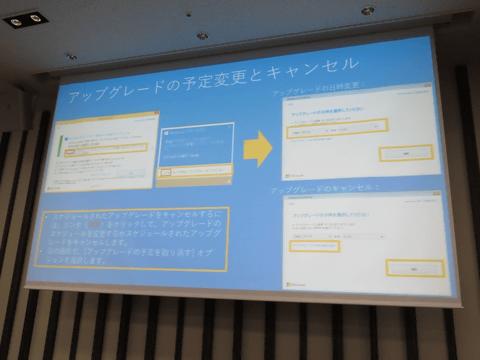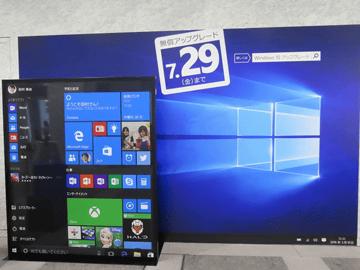
How to see how to upgrade to semi-strong Windows 10
The view of Mr. Kexing Ogahara
It had been closed for 50 days before the free upgrade of Windows 10 ended on July 29th.
At the same time, Microsoft in Japan has further accelerated the proposal to urge it to upgrade to Windows10. Criticism focuses on this "coercive" attitude.
Starting from mid-June, users who did not update Windows7 to SP1, and users who did not update to Windows8.1 and used Windows8 directly, will also display notifications on their desktops prompting them to upgrade to Windows10 for free. For non-target users, update to target OS, upgrade to Windows 10, and even take unexpected steps. Most of these users are thought to be willing to avoid updates, but Japan's Microsoft has been operating there.
I have to say that there is something wrong with the practice of Microsoft in Japan.
The biggest reason is that the "Get Windows 10" application displays in the latest status, "according to the Windows update settings, this PC will be upgraded in the next plan" and displays the scheduled date and time of the upgrade, but the problem is that you only need to press the "x" button in the upper right corner of the application that displays this statement. That doesn't mean you refuse to upgrade.
In previous Windows operations, the operation was usually cancelled if the "x" button was pressed. Microsoft in Japan will also display the latest Get Windows10 application before the fix "KB3095675" released on May 13, indicating that it can be cancelled by pressing the "×" button, but now this description no longer works.
As a result, jobs that inadvertently upgrade to Windows10 continue to occur. This has become a problem around the world. However, Japan's Microsoft sees no sign of improving on this. This seems to be an idea that adheres to this attitude until July 29. I know you want you to upgrade to Windows10 anyway, but this is ignoring the situation of users.
Not only individual users, but also the impact on enterprise users can not be ignored.

In large and medium-sized companies, such as information systems departments, and tried to introduce PC, but also carried out such controls, in small and medium-sized companies there is no professional department, Windows in the field department of the work process 10 has occurred "trouble", such as starting to upgrade.
Some companies have heard of such an example: upgrading to Windows10's PC, the accounting reimbursement system becomes unavailable, causing problems with the backlog of business to gush out. Although it has the advantages of being able to achieve the latest security environment, it may cause obstacles to the business if it is not properly verified.
In fact, there is still a lot of Windows 7 use in enterprises. That can be said to be overwhelming.
In the "Enterprise IT trend Survey 2016" released by the Japan Information system users Association (JUAS), the number of enterprises that introduced Windows7 reached 87.7%. After the end of Windows XP support in April 2014, 80.9 per cent of the previous year's survey began and increased. Moreover, the introduction of Windows10 will remain at less than 1 per cent.
In the case of more than 80% of Panasonic for commercial use, more than half of the shipments are carried by Windows7 or downgraded to Windows7. It is characteristic of Japanese companies that they are more attached to Windows7 than individual users.
In the industry, due to the end of the shipment of Windows8 carrying PC at the end of June this year, in order to downgrade to Windows7, enterprises that want to buy this point one after another, resulting in a little special demand. On October 31, 2016, greater special demand is expected, as shipments of PC with Windows7 and PC with Windows8.1 are coming to an end. Still, the center that enterprises use is Windows7, which hasn't changed.
Then again, what makes people care is that the temperature difference is different from the rest of the world at the Microsoft news conference held in Japan on June 10, as the second Windows 10.
The question of upgrading to Windows10 has also been raised in Congress, and the submission of a defense in the name of Prime Minister Shinzo Abe has attracted much attention as a matter of national concern, and its "coercive" attitude has also triggered cries of condemnation.
At the press conference, questions about this point were also raised one after another among reporters. Japan's Microsoft retorted that "this is not mandatory" on the grounds that it has prepared a pass that can be cancelled and can be restored within a month after the upgrade. Moreover, although he repeatedly said that "the opinions were fed back to the headquarters in the United States", he replied that "there is no plan to reconsider the content of the notice", "you can't just change Japan" and so on.
This problem is not solved by preparing a path or a structure that can be restored to its original state, but by a forced upgrade structure that starts with an incomprehensible cancellation. The benefits of Windows10 called for by Microsoft in Japan are understandable, but there must be users who want to continue to use it in the current situation. Obviously, because the way of cancellation is difficult to understand, it adds extra labor and time burden to these users.
At the end of the press conference, he also had a dialogue with reporters to fuel the flames. Here, I also feel the reporter's intention to try to elicit an apology, but the head of the Windows business department is in trouble in answering a strong question, and it is regrettable to see the scene of asking the spokesman to follow up. Because for this problem, it also proves that the person in charge of the business is not positively engaged.
There are also cases where we have to follow the practices of the US head office directly. If we push it to July 29 in such a state, it is President Takuya Hirano's proposal to "provide cloud computing and equipment that we can happily use." This will be far away from the realization of the Japanese Microsoft slogan.
